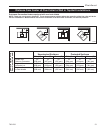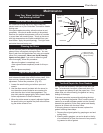
18
Dutchwest
7001219
Use the Air Control Settings
that Work Best for You
No single combination of control settings will fit every
situation. Each installation will differ depending on the
quality of the fuel, the amount of heat desired, and how
long you wish the fire to burn.
Control settings also depend on your particular instal-
lation’s “draft,” or the force that moves air from the
stove up through the chimney. Draft is affected by such
things as the height, type, and location of the chimney,
local geography, nearby obstructions, and other factors.
Too much draft may cause excessive temperatures in
the stove. On the other hand, too little draft can cause
backpuffing into the room and/or the “plugging” of the
chimney and catalytic burner.
How do you know if your draft is excessively high or
low? Symptoms of too much draft include an uncontrol-
lable burn or a glowing-red part of the stove or chimney
connector. A sign of inadequate draft is smoke leaking
into the room through the stove or chimney connector
joints.
When first using the stove, keep a record of the results
you achieve from different control settings. You will
find that specific control settings will give you a fixed
amount of heat. It may take a week or two to determine
the amount of heat and the length of burn you should
expect from various control settings.
Most installations do not require a large amount of
combustion air, especially if adequate draft is available.
Do not attempt to increase the firing rate of your heater
by altering the air control adjustment range outlined in
these directions.
In some newer homes that are well insulated and
weather-tight, poor draft may result from insufficient
air in the house. In such instances, an open window
near the stove on the windward side of the house (side
against which the wind is blowing) will provide the fresh
air needed.
A better option for assuring the delivery of adequate
combustion air is to duct air directly to the stove from
outside the house. In some areas, provisions for out-
side combustion air is required in all new construction.
Check your local codes.
Use the air control settings indicated in Figure 24 as
a starting point to help determine the best settings for
your installation.
NOTE: The thermometer should be used only as a
general indicator of temperature output. The “Inactive”,
“Normal”, and “Hot” temperature range demarcations
do not have function significance on the Dutchwest
Model 2463. Normal operating temperatures will range
within 500°F - 700°F from a well-established fire.
DO NOT OPERATE THE STOVE WITH THE ASH
DOOR OPEN. OPERATION WITH THE ASH DOOR
OPEN CAN CAUSE AN OVERFIRING CONDITION
TO OCCUR. OVERFIRING THE STOVE IS DANGER-
OUS AND CAN RESULT IN PROPERTY DAMAGE,
INJURY, OR LOSS OF LIFE.
How to Build and Maintain a Wood Fire
Loading Wood
Your Dutchwest Convection Heater accepts wood from
both the front and side. Front loading is useful for kin-
dling a new fire and adding an occasional log, however,
we recommend side loading as most convenient when
adding several logs at a time. Always be certain that
the stove damper is open before opening either door.
WARNING: OPERATE YOUR DUTCHWEST CON-
VECTION HEATER ONLY WITH THE DOORS FULLY
CLOSED EXCEPT WHEN REFUELING.
THIS STOVE IS HOT WHILE IN OPERATION! KEEP
CHILDREN, CLOTHING, AND FURNITURE AWAY.
CONTACT MAY CAUSE SKIN BURNS.
Primary Air Underfire Air
Position of primary air control
lever for different burn rates.
Low 1/8 turn open
Medium 1/2 turn open
High full open
Number of turns the air control
is open for different burn rates.
Fig. 24 Primary and Underfire air settings.
High
Med.
Low
Closed


















